Munich High End 2015: The Key Kim Report
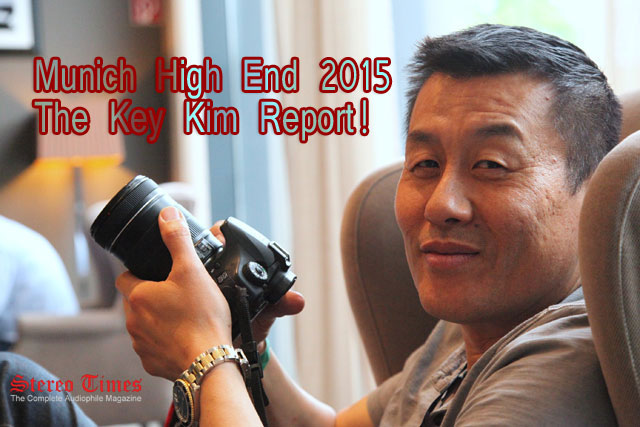
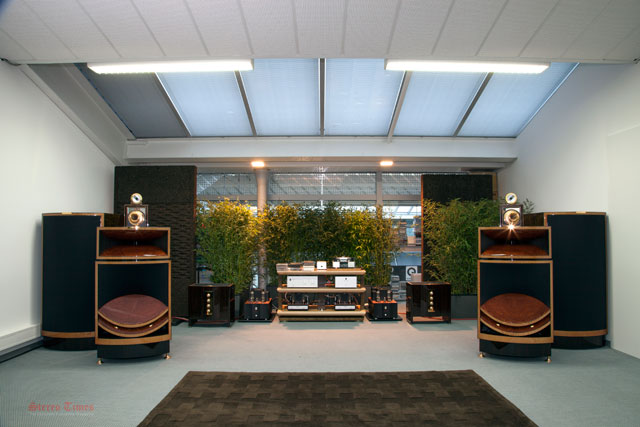
Once again like last year the Living Voice and Kondo Audio Note turned out to be the best sounding room. This room was packed full of people so that it was always hard to get a seat and sometimes hard to get into the room. Fortunately, I managed to find a sweet spot and, boy, it sounded fabulous. Hats off to Kevin Scott of Definitive Audio as he once again put together a stunningly gorgeous sounding room. This suite featured the superbly finished Living Voice Vox Olympian loudspeakers, a four-way horn-loaded loudspeaker coupled with an Elysian horn loudspeaker system, and horn loaded sub woofers. They were driven by all Kondo Audio Note electronics; the captivating Kagura 211 monoblock amplifiers powered the Elysian horn loudspeakers and the Gakuoh monoblock amplifiers powered the horn loaded subwoofers. All cabling was the new Kondo KSL silver. The music was rendered absolutely naturally with a realism which was like listening to live music. Listening to the Giancomelli – Sposa, non mi conosci, a Cecilia Bartoli’s performance was captivating: her voice proved to be both effortless and nimble while the system produced an impressive three dimensional soundstage. It was as if I were in the concert hall listening to a live performance.
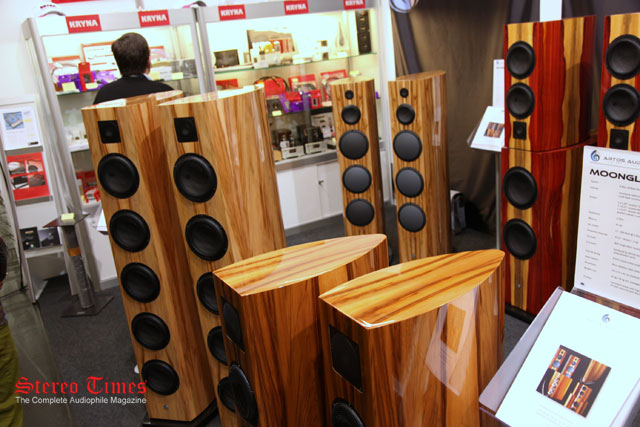
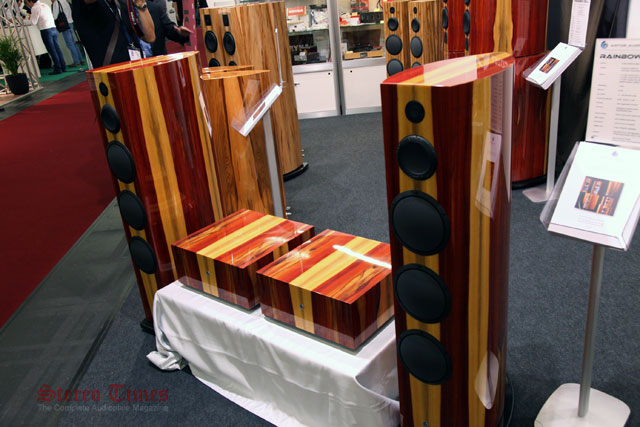
Wow! What a surprise to see the Artos Audio (formally Consensus Engineering loudspeakers) and the Karan Acoustics in the same room. I’ve been using both their products as my reference for some years now. Christoph Kraemer who now serves as the company’s CEO, took over the helm in 2012 and still maintains operations north of Dusseldorf in the city of Krefeld, Germany. The first thing anyone notices about Artos Audio loudspeakers is their cabinet. The multi layered finishes are exquisitely unique and beautiful. Looking for differences between it and my older Consensus brand, I noticed they come equipped with Accuton’s newest Cell drivers (graphite-coated ceramic drivers). Kreamer says Accuton custom designs voice coils for Artos Audio to avoid the use of resistors in the crossover. I asked Kraemer if there’s any difference between the CAE Conspiracy loudspeakers and Artos Audio’s, and he told me that Artos Audio utilizes better drivers, crossovers, and cabling. I was able to hear all three loudspeakers (albeit under small makeshift room conditions), starting with the Sunrise ($18k), then the Rainbow Cell ($32k) and finally, the Mirage ($42k). These prices are still up there but I don’t know how Kraemer could manage to keep the prices much lower than many other loudspeaker manufacturers who also use Accuton drivers.
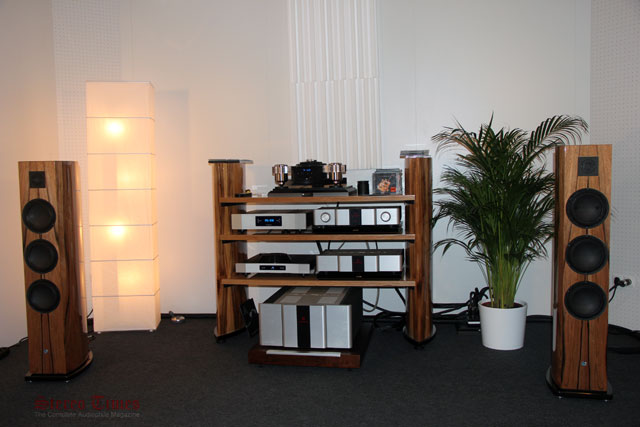
The Artos Audio suite used the powerhouse Karan Acoutics KAS600 stereo amplifier and KAL ReferenceMK3 fully balanced preamplifier (Class A with external power supply). I was very impressed with the overall sound despite the surroundings, as I found it transparent, detailed and open sounding with great timbre and weight. Due to the limitations of the room, on certain tracks the bass got a little overwhelming, but I know those thin walls were the culprit. The good news is I have a pair of the big Mirage coming my way so stay tuned.
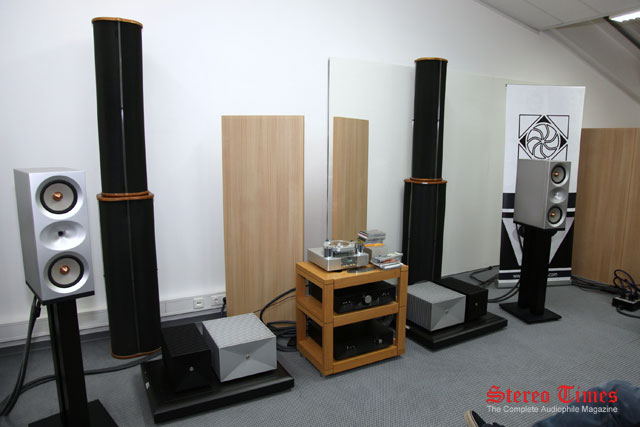

The Thrax Audio suite was one of my favorites at this year’s show. This was also the first time I got the chance to see and hear the company’s new Lyra monitor loudspeakers AND the premier of the Mark Dohmann Helix 1 turntable (Mark Dohmann designed the Continuum Calliburn and Cobra turntable). The system featured the stunningly full-range sounding Lyra, a two- way design stand mounted loudspeaker ($20k). The Lyra incorporates a new breed of innovative high frequency driver loaded with a special horn system, complimented by 2 magnesium diaphragm mid/bass drivers in beautifully crafted aluminum vented and d’Apollito styled enclosure. Many two-way stand-mounted monitors cut off the bass well below the 40Hz mark, but the Lyra claims to offers bass that extends comfortably to the mid-30Hz range. It is that regard that the Lyra sounds more like a full range floorstander. The Lyra were driven by a pair of Thrax Audio Teres mono amps ($30k/pair) which serve as my new reference amplifiers (review in the works). Also on hand, were Hero mono amps ($36,500/pair), the Dionysos preamplifier ($21,500), the Maximinus ($38,500) universal DSP controlled discrete resistor ladder 32bit/384kHz DAC, a CEC transport, Orpheus ($21,500) phono-preamplifer with LCR RIAA equalization utilizing two tube gain stages with zero negative feedback. The Helix 1 turntable ($40k) comes with a Frank Schroder carbon fiber CB tonearm: both products are made and available exclusively from Thrax Audio. As displayed, a Swedish Analog Technology tonearm ($30k) was used as a second tonearm. The two arms were equipped with Lyra Atlas and Etna cartridges respectively. The Helix 1 is a belt-driven turntable and brilliantly utilizes the MinusK vibration system. MinusK technology is used in a broad spectrum of applications including nanotechnology, semiconductor, and zero-G simulation for spacecraft. The support bearing uses a specially modified Spiral Groove section. The Thrax system produced superb sound in both digital and analog. The Lyra is a serious contender as it rendered music in a most musical manner that was both detailed, highly transparent while it handled image and focus with equal dexterity. But most importantly, it was a musical presentation. Nothing like what I have sometimes heard in other aluminum built enclosures. The cabling was the incredibly engineered EnKlein David series (made in the USA) throughout.
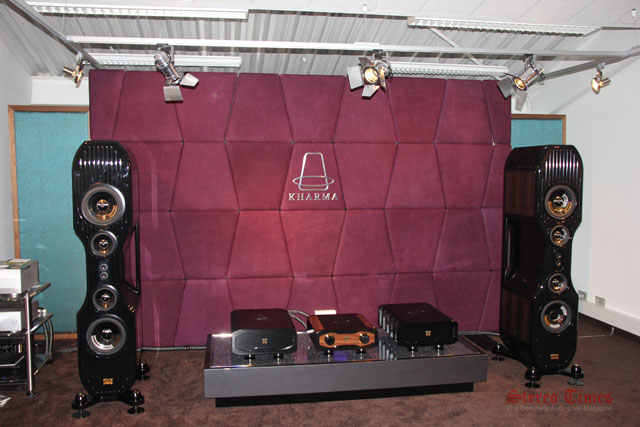
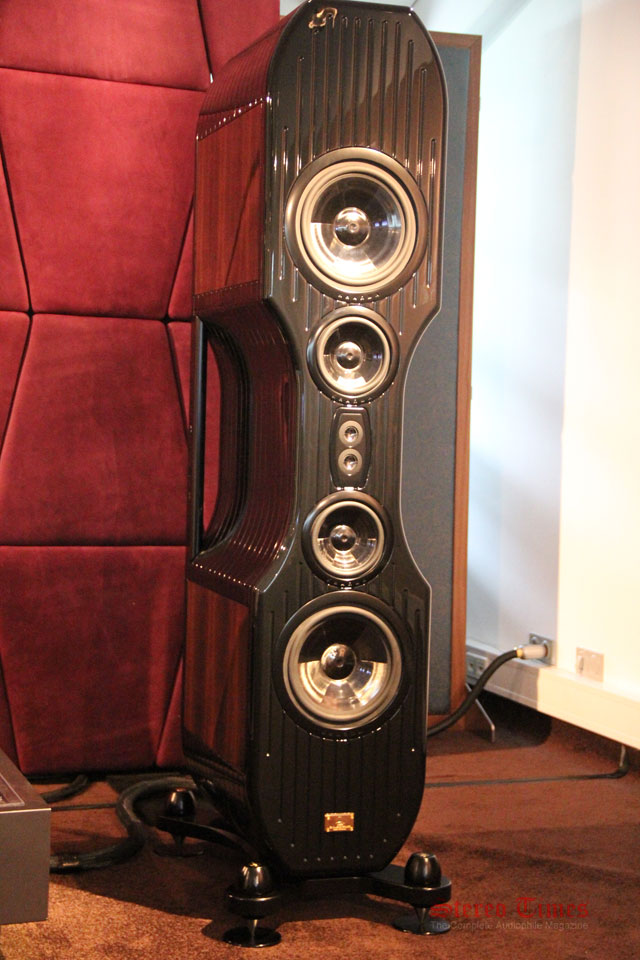
The new and strikingly attractive Kharma Exquisite Midi Grand loudspeakers ($216,000) incorporates the newly developed ENIGMA VEYRON driver (World premiere Kharma Omega- F driver). The F stands for zero Foucault current which is an innovative patented ironless magnet motor system that completely eliminates Eddy currents. This results in a driver that responds much faster with less distortion and vastly increased resolution and detail. To improve the new Omega-F driver even further, the cones are optimized with the strongest high-tech carbon fiber technology. The dust cap, voice coil, cone, and chassis are made of carbon. Lastly the driver connectors are of Kharma silver alloy which is used for the crossover cables and external cables. Kharma Omega-F driver series are available in both 7-inch and 11-inch sizes. The Exquisite Midi Grand loudspeakers are equipped with the Kharma Diamond Stand, a newly developed stand for the various Exquisite models. The unique feature is that the stand is equipped with real diamonds and has luxurious spike disks. The Exquisite Midi Grand Loudspeakers were driven by stunningly built Kharma Exquisite Electronics, the MP1000 mono amps and P1000 preamplifier sounded superb. I could’ve stayed and listened all day but I had to run and cover the rest of this humongous show. Kharma cables were used throughout the system along with their beautifully crafted power block.
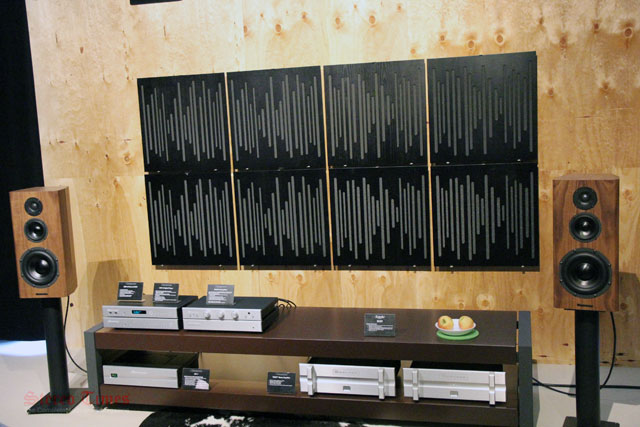

As Bryston is popularly known at designing affordable high end components for both consumers and the professional audio marketplace. My perception of Bryston has officially changed. Not only do they make excellent and affordable electronics but they also build outstanding loudspeakers as well. The Bryston Mini T bookshelf loudspeakers ($3,695/pair) sounded very impressive overall. Driven by all Bryston electronics that included the 7B-SST mono amps ($5,100/pair), BP-26 preamplifier ($2,995) with a MPS-2 matching power supply ($1,695), BDP-2 digital player ($2,195) with the BDA-1 DAC ($2,195). Bryston is producing really impressive speakers with real world prices. I’m very glad that I stopped by Bryston’s suite and gave a listen. The room sounded really solid and alive with excellent space and ease. Hard to believe at this price point. That goes to show that you don’t have to spend ton of money to get great sound.
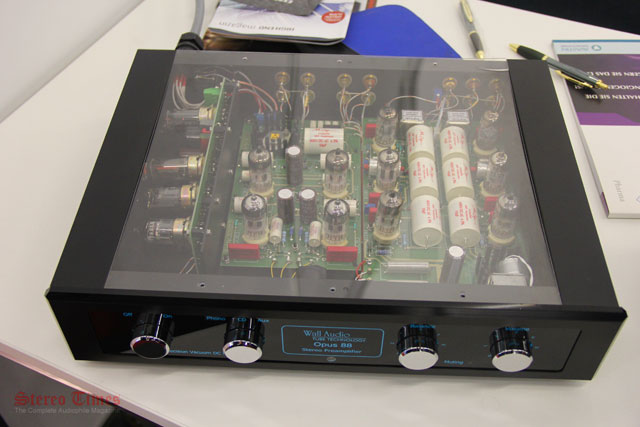
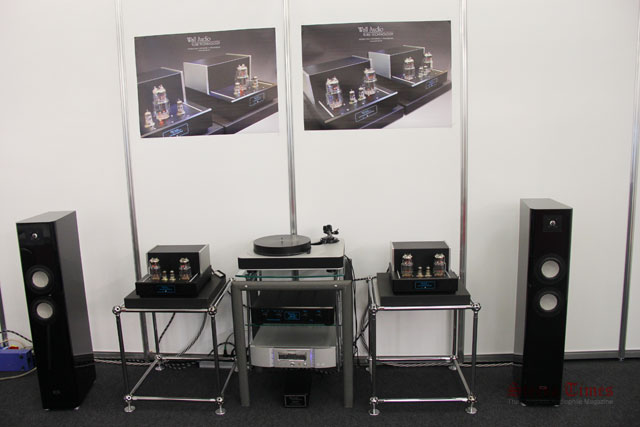
Wall Audio showcased their M50 mono amplifiers ($11,750/pair) and the Opus 88 preamplifier ($5,950). The M50 is a PSET (Parallel Single Ended Triode) 35 Watts per channel in Class-A, a no negative feedback design using the Russian 6C33 output tubes with automatic stabilized bias current of power tubes. I wasn’t really able to listen to the system to evaluate the sound because they were not set up in an ideal surrounding, in an open booth where it was very noisy with lots of distractions. However, I was able to hear the beauty of timbrel rightness and the midrange purity that Wall Audio possesses. (review in works).
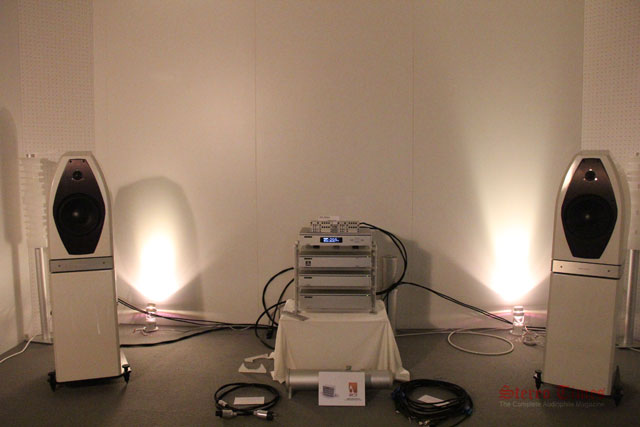
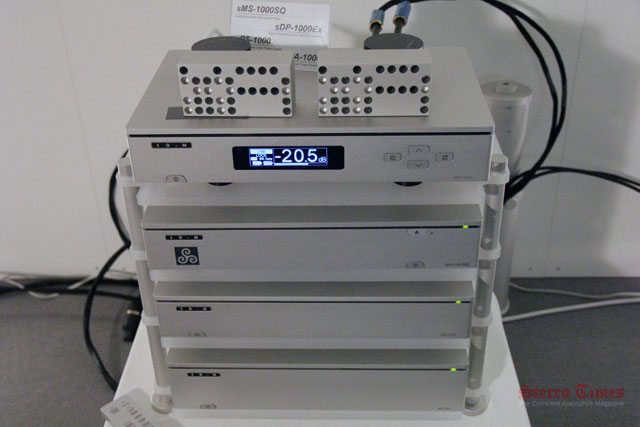
SOtM and Hemingway Audio are manufacturered in Korea and stands for Soul of the Music. The company specializes in Hi-Fi and PC-Fi audio products since 2008. Hemingway Audio is an innovative cable manufacturer that employees the world’s first patented Frequency Modulation Cavity Fundamentals (FMCF) technology. It is a technology which is used to control the magnetic field. Hemingway’s unique cable structure uses air as an insulator and to convert the magnetic field. They were teamed up with the Eggleston Works and created another great sounding suite. The Eggleston Works new Camila two-way loudspeaker ($14k/pair) with a nicely styled integrated stand utilizes a 1” soft dome tweeter and 9″ Morel woofer. The Camila was driven by a SOtM sPA-1000 (200 watt Class D stereo amplifier $4,500). The rest of the system consisted of SOtM sDP-1000EX DAC/preamplifier ($3500), the SOtM sMS-1000SQu music server/player ($3k), the SOtM sPS-1000 power supply ($1k), LAN signal noise filter SOtM iSO-CAT6 ($350), and room tuning and rack by TAKT. All cables were by Hemingway cables, entry level Indigo Series which utilizes patented FMCF technology. The system produced quite a good feel sonically considering how challenging most of these showrooms are.
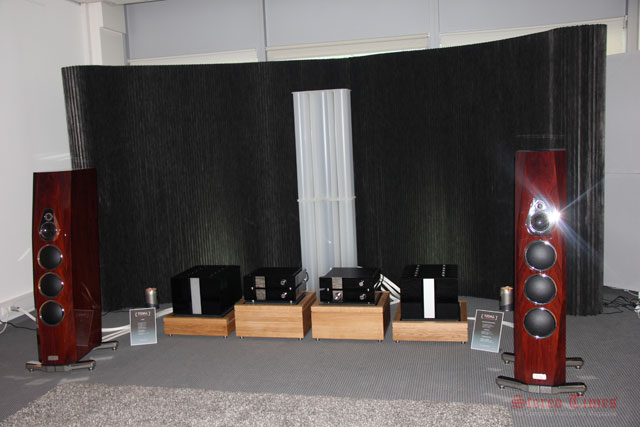
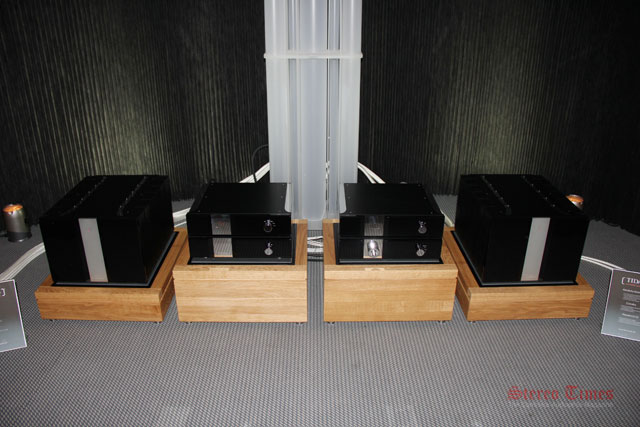
Tidal Audio from Germany debuted three new products: The Tidal Akira loudspeaker ($180k) utilizes the first true diamond midrange driver. In this Jorn Janczak technology from 170 Hz and up is handled by the pure diamond drivers. It uses the exclusive drive-cabinet technology of the La Assoluta within an only a 1.4m tall speaker for smaller or medium sized living rooms. The Akira loudspeaker was driven by the new Assoluta monoblock amps ($150k): a true mono amplifier with an active regulated power supply for all the current and voltage sections. The Assoluta utilizes three high silver hollow-conductor EMV transformers, and a complex 4 separate PCB boards. Also shown was the Camira DAC ($42k) a discrete NOS (non-over-sampling) ladder-DAC , and employs a unique Iso-re clock technology that makes for extremely low jitter. The sound was ultra transparent with lots of little details expanding across a wide and expansive stage which proved very entertaining. Every year this room just keeps getting better. One of my top favorites!
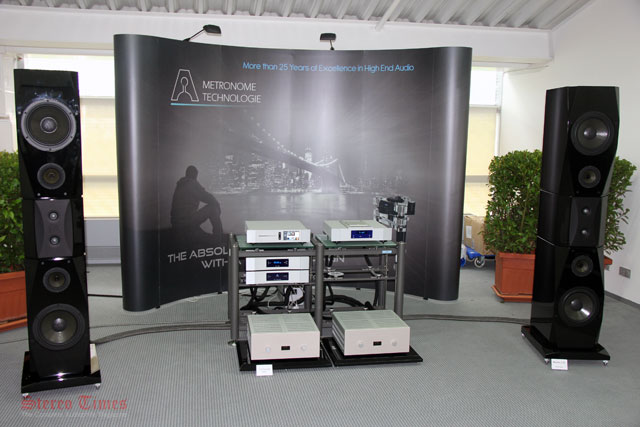
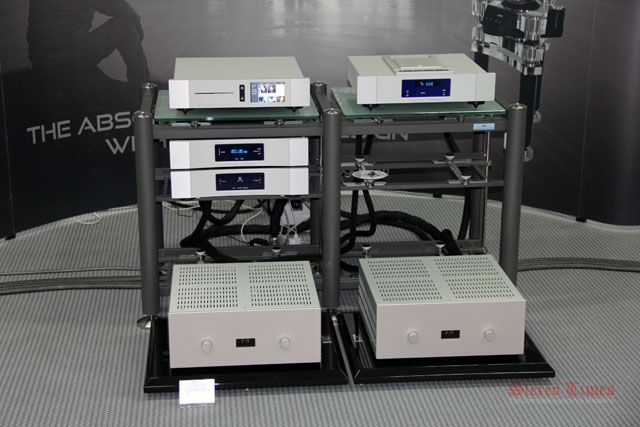
Focus Audio featured its new Liszt Concerto mono amps ($35k/pair) employing EL34 output tubes that produce 70-watts per channel and their Master 2 BE ($45k) loudspeakers. The Master 2 B2 is a large floorstander equipped with a pair of beryllium tweeter, two 5” Eton midrange drivers, and two 11” Eton woofers arranged in D’Appolito-type configuration. Digital source was by Metronome of France. The Master 2 BE loudspeakers were driven beautifully by the Liszt mono amps and together they projected an impressive three-dimensional soundstage. In the end, this was another room I had to pull myself away from.
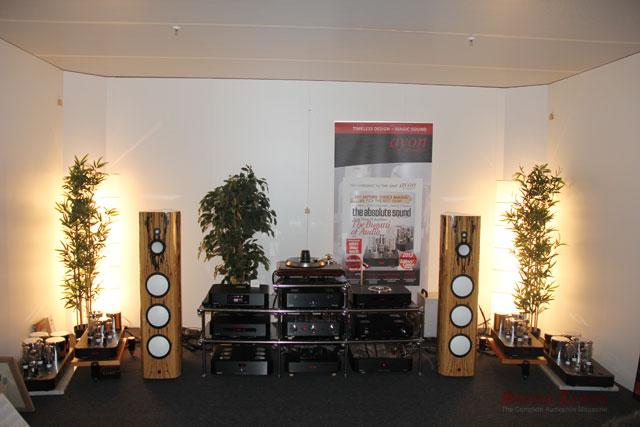
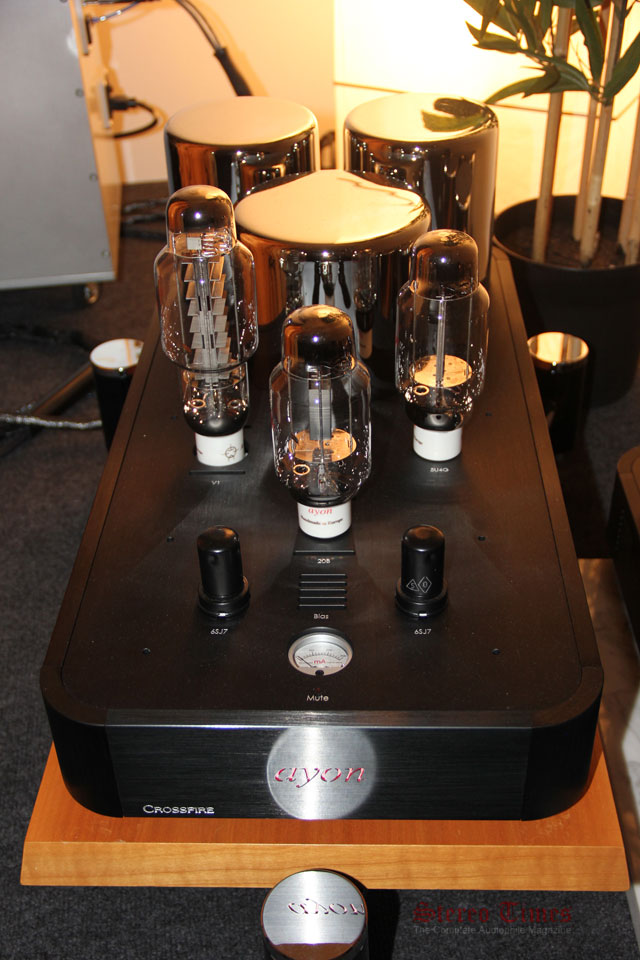
Lumen White showcased their new state-of-the-art White Light Anniversary loudspeakers at 70k/pair to celebrate their 15 year anniversary. The White Light Anniversary a three-way floorstander incorporating five-drivers. They utilize a unique proprietary port-loading-and air-damping technology and when driven by all Ayon electronics the results are always superb. The rest of the system was comprised of Crossfire Evolution monoblock amps ($25k), the Spheris III linestage preamplifier $33k), along with the Sigma DAC ($4k) and Stealth DAC ($7) DAC feeding the CD-T CD transport ($5k). The Spheris phonostage ($29k) and Mystere turntable ($65k) were used. Again, the sound was smooth, rich and detailed with a nice soundstage that was very inviting despite their small confines.
God Willing, I’ll see you again next year!

Stereo Times Masthead
Publisher/Founder
Clement Perry
Editor
Dave Thomas
Senior Editors
Frank Alles, Mike Girardi, Russell Lichter, Terry London, Moreno Mitchell, Paul Szabady, Bill Wells, Mike Wright, and Stephen Yan,
Current Contributors
David Abramson, Tim Barrall, Dave Allison, Ron Cook, Lewis Dardick, John Hoffman, Dan Secula, Don Shaulis, Greg Simmons, Eric Teh, Greg Voth, Richard Willie, Ed Van Winkle, Rob Dockery, Richard Doron, and Daveed Turek
Site Management Clement Perry
Ad Designer: Martin Perry





Be the first to comment on: Munich High End 2015: The Key Kim Report